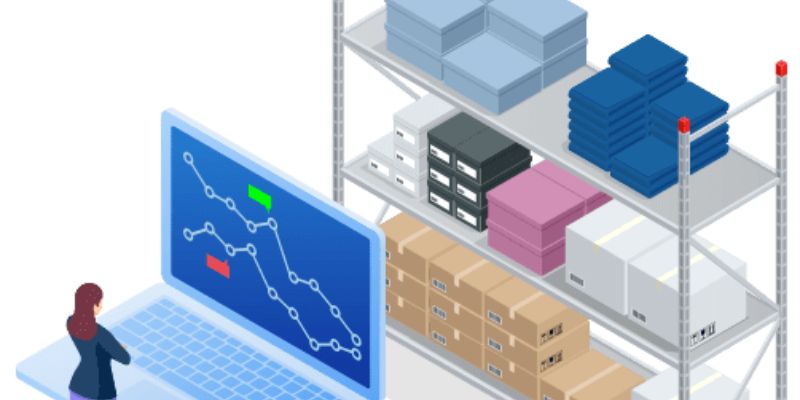
Network Inventory Management: Simplifying Your Business Operations
Jan 31, 2024 By Lucy Lee
In today's digital age, businesses rely heavily on their network infrastructure to operate efficiently. It makes it crucial for companies to understand their network inventory and how it is managed clearly. This article will discuss the importance of network inventory management and its benefits.
What is network inventory management?
Network inventory management refers to tracking and managing the assets within a network infrastructure. It includes keeping a detailed record of all hardware, software, and network devices connected to the network.
By maintaining an accurate inventory, organizations can better manage their resources, plan for upgrades or replacements, and ensure the security and stability of their network.

What is the main purpose of inventory management?
The main purpose of inventory management is to ensure that a business has the right amount of stock on hand to meet customer demand while minimizing the costs associated with holding excess inventory.
Effective inventory management involves monitoring and controlling the flow of goods from the point of purchase or production to the point of sale or consumption. It includes forecasting demand, determining optimal inventory levels, and implementing systems and processes to track and manage inventory.
By maintaining appropriate inventory levels, businesses can avoid stockouts and backorders, improve customer satisfaction, reduce carrying costs and storage space requirements, and optimize cash flow.
Additionally, inventory management can help businesses identify trends, manage supplier relationships, and make informed pricing, promotions, and product assortment decisions.
Types of Network Inventory Management Assets
Regarding network inventory management, several types of assets should be included in the inventory.
Hardware assets
First and foremost, hardware assets should be recorded. It includes servers, routers, switches, firewalls, and other physical part of the network infrastructure. It is important to document important details such as the manufacturer, model number, serial number, and location of each hardware asset.
Software assets
Software assets are another crucial part of the network inventory. It includes operating systems, applications, and other software installed on the network devices. It is important to keep track of each software asset's version numbers and licenses to ensure compliance and facilitate updates and patches.
Network devices
In addition to hardware and software assets, network devices should also be included in the inventory. It includes IP addresses, domain names, and any other unique identifiers for each device on the network. Organizations can easily identify and troubleshoot any issues by documenting the network devices.
Practical Tips and Strategies for Effectively Managing Network Inventory
Effectively managing network inventory is crucial for maintaining a well-functioning and secure network infrastructure.

Here are some practical tips and strategies for efficient network inventory management, with a focus on the use of automated tools and software:
Document and categorize
Start by documenting all the devices and equipment in your network, including routers, switches, firewalls, servers, and endpoints. Categorize them based on their type, location, and function. It will help you have a clear overview of your network inventory.
Implement an automated inventory management tool.
Utilize specialized inventory management software that automatically discovers and tracks your network's devices. These tools use techniques like network scanning and SNMP (Simple Network Management Protocol) to gather information about devices, such as their IP addresses, MAC addresses, and configurations.
Regularly update and reconcile inventory.
Set up automated processes to regularly scan your network and update inventory records. It helps ensure accuracy and avoid discrepancies between the actual devices and the recorded inventory. Implement periodic reconciliation checks to identify any discrepancies and take corrective actions promptly.
Track hardware and software detail
Alongside basic device information, maintain a comprehensive record of hardware specifications (such as model numbers, serial numbers, and firmware versions) and software details (such as operating systems, installed applications, and licenses). This information is crucial for maintenance, upgrades, and license compliance.
Monitor device health and performance.
Utilize network monitoring tools that can provide real-time insights into the health and performance of your network devices. These tools can alert you to high CPU usage, low memory, or abnormal network traffic patterns. By proactively addressing these issues, you can prevent downtime and optimize network performance.
Integrate with IT asset management.
Integrate your network inventory management system with your overall IT asset management processes. It gives you a holistic view of your organization's IT infrastructure, including hardware, software, licenses, and warranties. It enables better planning, budgeting, and decision-making.
Implement automation and workflows.
Leverage automation and workflows within your inventory management system to streamline repetitive tasks, such as device provisioning, configuration backups, and firmware updates. It saves time and minimizes the risk of human errors.
Regularly review and audit inventory.
Conduct periodic audits of your network inventory to ensure it aligns with the physical devices and their configurations. Remove any obsolete or unauthorized devices from the inventory to maintain an accurate representation of your network.
Benefits of Network Inventory Management
Cost Savings
By having accurate information about your network inventory, you can identify unused or underutilized resources, resulting in cost savings for your business. Additionally, proper management allows you to plan for future upgrades or replacements instead of making sudden purchases when equipment fails.
Improved Efficiency
With a comprehensive view of your network assets, you can better manage them by identifying potential issues before they become major problems. It helps prevent downtime and ensures smooth operations.
Enhanced Security
Knowing what devices are connected to your network enables you to monitor any unauthorized access attempts or suspicious activity more effectively. You can also keep track of security updates and patches needed for each device to maintain a secure environment.
Compliance Requirements
Many industries have specific data privacy and security regulations requiring detailed documentation of IT assets within a company's infrastructure. Properly managing your network inventory ensures compliance with these requirements.
Scalability
As businesses grow and expand their networks, having an organized inventory management system becomes even more critical. It allows for easier scalability without disrupting daily operations.
Conclusion
Effective management of your organization’s network inventory brings numerous benefits, including cost savings, improved efficiency & security compliance adherence, and scalability capabilities.
Therefore, it is essential to maintain a successful business. By implementing a network inventory management system, you can ensure the smooth operation of your business and stay ahead in today's competitive market.
-
 Entertainment Feb 01, 2024
Entertainment Feb 01, 2024The Boys in the Boat Review: A Film by George Clooney
Are you looking for a well-elaborated review of the movie "The Boys in the Boat" directed by George Clooney? Let's find out the story of the movie and how it has been directed.
-
 Entertainment Jan 31, 2024
Entertainment Jan 31, 2024Hot Wheels Unleashed 2 Turbocharged Review
Discover the details of the Hot Wheels unleashed 2 turbocharged action-packed racing game with exhilarating gameplay, brand-new tracks, and incredible car customization
-
 Health Jan 01, 2024
Health Jan 01, 20248 Best Exercises for Hypothyroidism
You can do low-impact exercises like walking, yoga, riding, Tai Chi, and strength training to deal with hypothyroidism
-
 Art Jan 31, 2024
Art Jan 31, 2024Discovering Conceptual Arts: A Comprehensive Overview of its Characteristics
This article will provide you with a comprehensive overview of the conceptual arts and its characteristics. Explore the role of contributors in the field of conceptual arts.